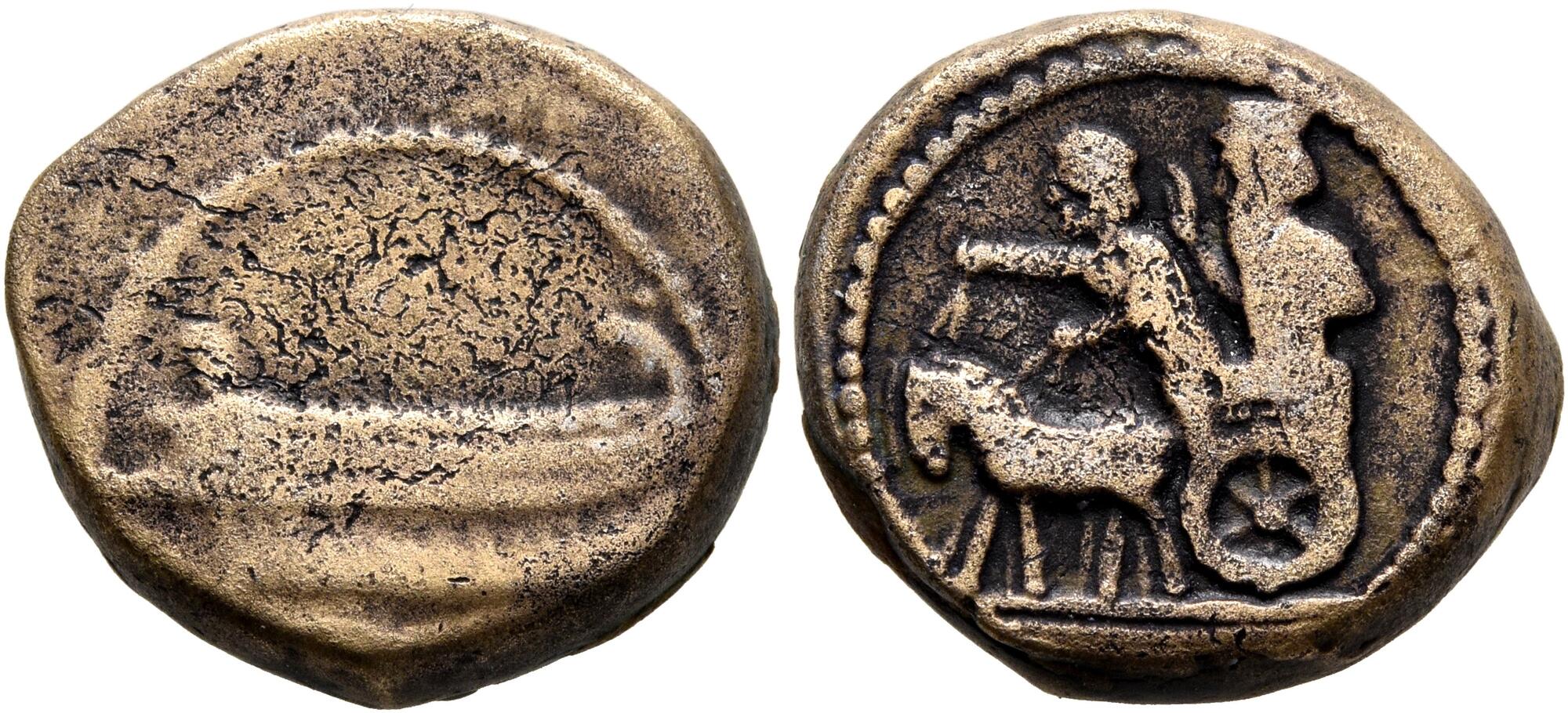Sidon, bronze, half shekels (galley/chariot) (370-333 BCE)
From SILVER
370 BCE - 333 BCE Bronze
Description
| ObverseInscription or printing placed on the obverse.: | Phoenician galley above waves left. |
| ReverseInscription or printing placed on the reverse.: | Persian king, raising his right hand, and driver, holding reins with both hands, in chariot left |
Mint and issuing power
| MintIdentifies the place of manufacture or issue of a numismatic object.: | Sidon | Ancient regionAncient region.: | Phoenicia | Modern countryModern country: Lebanon | AuthorityIdentifies the issuing power. The authority can be "pretended" when the name or the portrait of X is on the coin but he/she was not the issuing power. It can also be "uncertain" when there is no mention of X on the coin but he/she was the issuing power according to the historical sources: | Persian Empire |
Chronology
| FromIdentifies the initial date in a range assigned in a numismatic context. | 370 BCE | toIdentifies the final date in a range assigned in a numismatic context.. | 333 BCE | PeriodTime period of the numismatic object.: Classical 480-323 BC |
Physical description
| MetalThe physical material (usually metal) from which an object is made.: | Bronze |
Median weightMedian of the weights of numismatic objects (in grams). in grams | 6.00 | DenominationTerm indicating the value of a numismatic object. Examples: tetradrachm, chalkous, denarius.: | half shekel | StandardStandard.: |
Image

S2006 Sidon bronze half shekels.jpg [1]
References
| Die study referencePublication of the study: | Elayi - Elayi 20041Elayi - Elayi 2004, p. 349-365, n° 2321-2461 (Group IV.7.6) | ||
| Coin series referenceReference to coin series study: | HGC 102HGC 10, n° 248 | ||
| Coin series web referenceCoin series web references: | |||
Obverse dies distribution
| FrequencyFrequency of specimen in distribution. ᵖ | Number of obversesNumber of obverse dies. ᵖ (o) | % (o) | Number of coinsNumber of coins. (n) | % (n) | Die nameName(s) of the die(s). |
| 1 | 17 | 56.67 | 17 | 36.17 | 1, 2, 4, 5, 12, 16, 17, 18, 19, 21, 22, 23, 24, 25, 26, 28, 30 |
| 2 | 9 | 30 | 18 | 38.3 | 3, 7, 8, 10, 13, 14, 20, 27, 29 |
| 3 | 4 | 13.33 | 12 | 25.53 | 6, 9, 11, 15 |
| Total | 30 of 30 | 100 | 47 of 47 | 100 |
Reverse dies distribution
no distribution is available
Quantification
| Number of obversesNumber of obverse dies. ᵖ (o) | 30 | Number of singletons (o1)The number of singleton coins. ᵖ | 17 |
| Number of reverse diesNumber of reverse dies. (r) | Number of coinsNumber of coins. (n) | 47 | |
| Coins per obverse dieNumber of coins per obverse die. (n/o) | 1.57 | Coins per reverse dieNumber of coins per reverse die. (n/r) | |
| Reverse per obverse ratioRatio of obverse dies divided by reverse dies. (r/o) | Percentage of singletons (o1)number of coins (n) divided by the number of singletons (o1) ᵖ | 56.67 % | |
| Original number of dies (O) (Carter 1983 formula)The estimation of the number of coins according to Carter 1983 ᵖ | 66.67 | Coins struck if 20,000 as average productivity per dieCoins made if the average productivity for obverses (according to Carter) is 20,000. ᵖ | 1,333,400 |
| Original number of dies (O) (Esty 2011 formula)The estimation of the number of coins according to the singleton formula in Esty 2011 ᵖ (O) | 82.94 | Survival rate if 20,000 as average productivity per dieSurvival rate if average productivity is 20,000. ᵖ | 0.00004 |
| Coverage (o = % of O) (Esty 1984 formula)Esty 1984 - coverage (% of O) ᵖ (o = % of O) | 63.83% | Die productivity if survival rate 1/2,000Average productivity if survival rate is 1/2,000. ᵖ | 1,409.93 |
| Weight of silver (in kg) if 20,000 coins per die (O = Carter formula)Carter 1983 * Median weight * 20000 (*10 if gold or electrum) ᵖ | n.a. | Die productivity if survival rate 1/5,000Average productivity if survival rate is 1/5,000. ᵖ | 3,524.82 |
Remarks
References
- ^ Elayi, Josette - Elayi, Alain G. (2004), Le monnayage de la cité phénicienne de Sidon à l'époque perse (Ve-IVe s. av. J.-C.), Transeuphratène Suppl. 11, Paris, Gabalda, 2 v., 855 p., 77 pl.
- ^ Hoover, Oliver D. (2010), The Handbook of Greek Coinage Series. 10. handbook of coins of the Southern Levant : Phoenicia, southern Koile Syria (including Judaea), and Arabia, Lancaster-London, lxxix, 201 p.